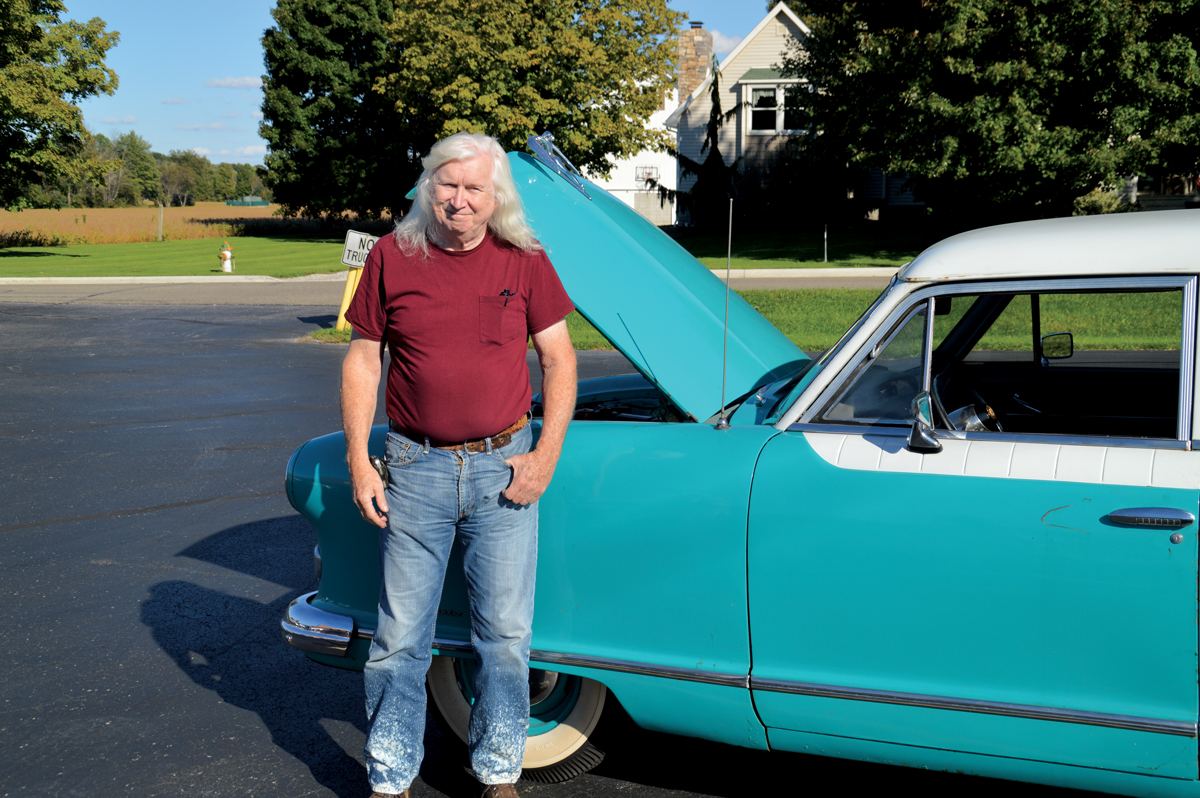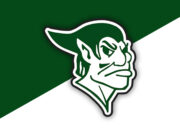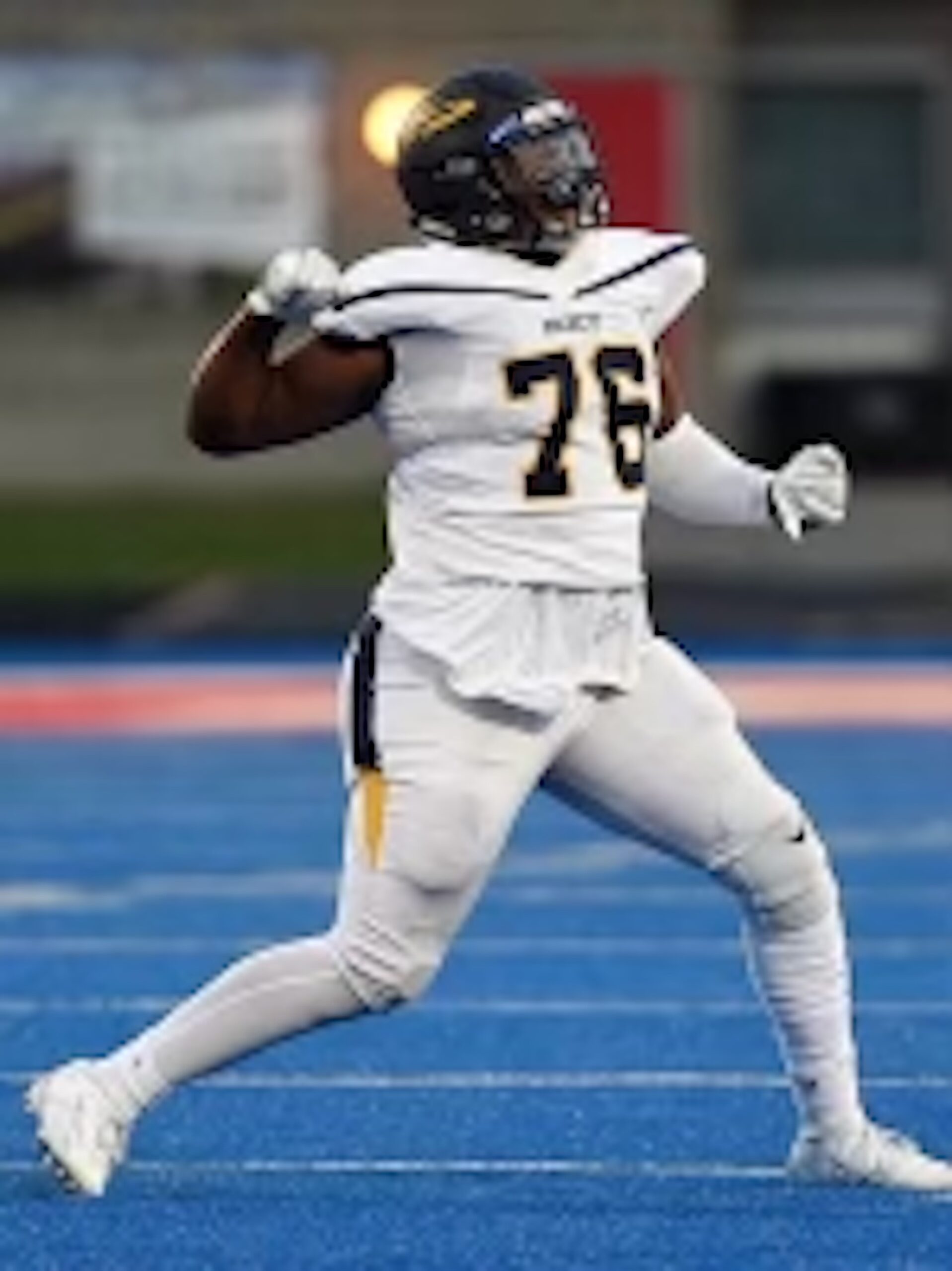“1950s Nashes were ugly. My father had Nashes. We’d get ‘em real cheap when they were a few years old and drive ‘em a while until something major went wrong. Nashes didn’t hold their values even in the 50s. They were always odd looking. Then we’d get another one. I have had Nashes—later American Motors automobiles—pretty much all my life including Javelins, AMXs, and Gremlins. The Pacers of the 1980s, they were really ugly!” So says Tim Cummings of Freedom who was spotted with his 1954 Nash Ambassador at the G-ville car cruise-in this past fall. Typically, there was a crowd around it. It was the only Nash for miles around. Many people didn’t know what it was, and it certainly is not your typical primped and polished show car. Tim says, “I wanted a 1951 Nash but they’re really scarce, impossible to find. Because of the uni-body construction they all rusted out beyond saving. I went to look at one that was advertised near Pittsburg. It was so far gone that it was barely a parts car. The seller wanted to practically give it to me. I turned it down. It was junk. My wife found this 1954 on the internet. It was advertised as blue, everything works. I looked at it. Most of the important things sort of worked, all but the steering. You could turn that steering wheel endlessly and nothing would happen. My wife wanted a blue car. And it was blue! The guy who was selling it also had several other old Nash cars. One of them still had a useable steering box and column. So, I persuaded him to put that in the deal. It now runs, stops and steers. I have to carry a fire extinguisher though because the wiring is so bad. Things spark. There is a radio delete and a clock delete—plates that cover the holes where these things should be. You don’t see these delete panels much anymore because the base packages on new cars include such amenities.”

The Nash motorcar company was founded in 1916 and featured an overhead valve engine with 9 main bearings—highly advanced for the time and way ahead of the competition—Ford. After the stock market crash in 1929 Nash merged with Kelvinator Appliance Company and shortly thereafter became profitable again. Many early 30s Nashes were sumptuous, beautifully styled with numerous special features. But they also sold low priced cars with much cheaper, ordinary side valve six engines—their bread and butter. Well into the sixties AMC was known for offering absolutely stripped-down versions of their cars. In about 1960, when I would have been about 14, a neighbor’s dad bought a new AMC Rambler. At that time, we were driving a 1959 Mercury with the usual amenities. I got to ride in the Rambler and was amazed and aghast at the absolute basic-ness of that car. There were little more than seats and a steering wheel. No radio, no clock, cheap, ill-fitting vinyl floor mats, a bare minimum speedometer with a couple idiot lights. But no matter what your opinion of the styling or lack of accouterments, Nash was known for reliability and economy.
Generally, the Nash philosophy was to offer a lot for the money, with innovations such as cowl ventilation, twin ignition eights (two sets of spark plugs for each cylinder), dashboard starter buttons, down draft carburetors, gearshifts on the dash, and aircraft style instruments. They did so in their upscale models. But they continued to specialize in base price, cheap cars. Throughout the 30s Nash continued to experiment with cheaper automobiles using the inexpensive side valve engines, introducing the La Fayette model billed as a depression beater in the later 30s. It only lasted a few years because the depression ended as WW II developed. In 1941 Nash went to unit construction or uni-body for all their cars. This was not a new concept. Chrysler had introduced it in the early thirties with their Airflow models though they retained the traditional frame and body concept with all their other models. Nash produced all their cars with uni-body construction and typically cost $805 less than comparable Ford models.
The 50s saw the continued development of the uni-body and the trend toward smaller, cheaper cars, thus the focus on Ramblers and Metropolitans (made in England). They still offered the larger ambassadors and airflytes at least through 1957 but the focus increasingly was on the smaller cars and the short-lived Nash Healy sports cars. In 1949, Nash introduced, an all-new and controversial streamlined body style that affectionately became known as the inverted, or upside down, bathtub. It was definitely distinctive and you either loved it or hated it. Also, to minimize drag coefficients, the wheel wells were minimized so that only the bottom third of the wheels could be seen. This further set them apart from all other cars. Lois Lane of the Superman Comics fame drove an odd-looking convertible Rambler wherein the doorframes and side windows remained up and in place with the top folded down. These are so rare that they command a fair price today if you can find one. Superman was frequently depicted in a bathtub Nash.
Uni-body construction had no frame under them. The body was constructed so that it was essentially the frame and support, which was all well and good for the first, say ten years. When these early uni-body cars began to rust out, the hidden parts rusted equally as badly, and the cars would collapse and subsequently got scrapped. Also, because they were considered a low dollar, used automobile, people did not repair the bodies but simply discarded the cars. Consequently, fifty and sixty years down the line, there are not many of them left.
Cumming’s Nash is in every sense of the word a Drivable Dream. “It is a nice old beat up car. Half of the gauges do not work; the car needs a new wiring harness. The car has rust bubbling through here and there over previous bodywork. The interior is worn and not beautiful, but it is functional. The chrome is pitted, the paint scored and scratched. The overdrive is broken so 50 mph is as fast as it will go, he says.” But this is one of his show cars. Since retiring he also has redone a 1967 Plymouth Roadrunner. The plan for the Nash is to fix some of the wiring and get the overdrive repaired, but otherwise leave it as is. People seem to flock to it. Probably the most unusual aspect of this car is the hood ornament, which came right from the factory and is attributed to some famous sculptor. Actually, these hood ornaments are now in demand and are often worth more than the cars. It is an all chrome, voluptuous, naked, winged goddess that is sure to catch the eye of passersby. One elderly lady who noticed it remarked that it was obscene, and he should promptly remove it.
Another built in feature that Nashes are known for is the front seats that fold back into a double bed. In the 1930s, 1940s and 50s this was a popular feature for travelers when motels were not nearly as numerous as today but there were tourist cabins which were little more than a double bed. Nash advertised it as great for the hunter and fishing crowd. Comedians of the day added it depended on what you were hunting. But it became even more popular with the young dating crowd who often proclaimed Nashes were the best @#$%*& cars in America. A frequently heard mother’s mantra of the day went something like “good girls don’t date boys with Nashes”.

















